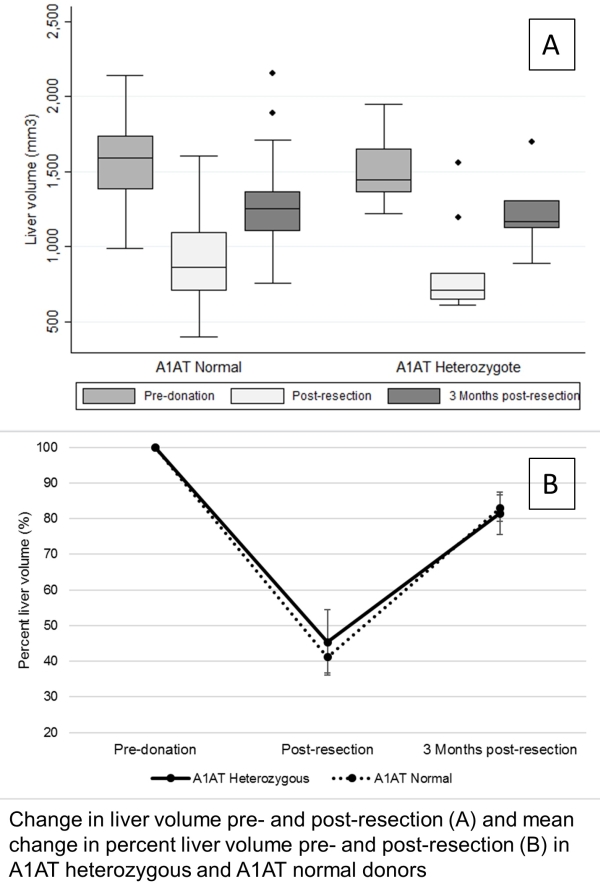Living Liver Donation is Safe in Donors Heterozygous for an alpha-1 Antitrypsin Gene Mutation
1Division of Gastroenterology, University of Pennsylvania, Philadelphia, PA
2Division of Transplant Surgery, University of Pennsylvania, Philadelphia, PA
3Center for Clinical Epidemiology and Biostatistics, University of Pennsylvania, Philadelphia, PA.
Meeting: 2018 American Transplant Congress
Abstract number: D238
Keywords: Donation, Liver transplantation
Session Information
Session Name: Poster Session D: Liver: Living Donors and Partial Grafts
Session Type: Poster Session
Date: Tuesday, June 5, 2018
Session Time: 6:00pm-7:00pm
 Presentation Time: 6:00pm-7:00pm
Presentation Time: 6:00pm-7:00pm
Location: Hall 4EF
Patients homozygous for an alpha-1 antitrypsin mutation, particularly the Pi*ZZ phenotype, develop cirrhosis and pulmonary emphysema. Those with a heterozygous phenotype are thought to have an increased risk of liver disease and cirrhosis when a second contributing cause is present. The aim of this study was to determine whether A1AT heterozygous living liver donors (LLDs) are at increased risk of complications after partial hepatectomy. This was a single-center retrospective cohort study comparing the outcomes of A1AT heterozygous to A1AT normal phenotype adult LLDs. Between 2010-2016, 11 A1AT heterozygous LLDs were identified and compared to 57 A1AT normal LLDs. There were no significant differences in donor sex, age or race/ethnicity between the two groups. A1AT heterozygous LLDs were most commonly Pi*S (45.5%) or Pi*Z (36.4%) variants, and had significantly lower serum A1AT level (median 100mg/dL vs 131mg/dL; p<0.001). A majority of LLDs in both groups underwent right hepatectomy (81.8% A1AT heterozygous vs 66.7% A1AT normal; p=0.542). There was no significant difference in median post-resection liver volume (706mm3 in A1AT heterozygous vs 859mm3 in A1AT normal; p=0.154). Hospital length of stay was also not different (median 5 days in both A1AT heterozygous and normal LLDs; p=0.892). Changes in liver volume pre- and post-resection for both groups are shown in the Figure. There was no difference in the ratio of pre- to 3-month post-resection liver volume between A1AT heterozygous and normal LLDs (median 0.81 vs 0.83; p=0.917). Similarly, there was no statistically significant difference in serum bilirubin, aspartate aminotransferase, alanine aminotransferase or alkaline phosphatase levels at 1 and 3 months post-resection between the two groups. In conclusion, the presence of a heterozygous mutation for the alpha-1 antitrypsin gene should not be a contraindication for living liver donation. 
CITATION INFORMATION: Bittermann T., Wood L., Abt P., Shaked A., Olthoff K., Goldberg D. Living Liver Donation is Safe in Donors Heterozygous for an alpha-1 Antitrypsin Gene Mutation Am J Transplant. 2017;17 (suppl 3).
To cite this abstract in AMA style:
Bittermann T, Wood L, Abt P, Shaked A, Olthoff K, Goldberg D. Living Liver Donation is Safe in Donors Heterozygous for an alpha-1 Antitrypsin Gene Mutation [abstract]. https://atcmeetingabstracts.com/abstract/living-liver-donation-is-safe-in-donors-heterozygous-for-an-alpha-1-antitrypsin-gene-mutation/. Accessed December 19, 2025.« Back to 2018 American Transplant Congress
